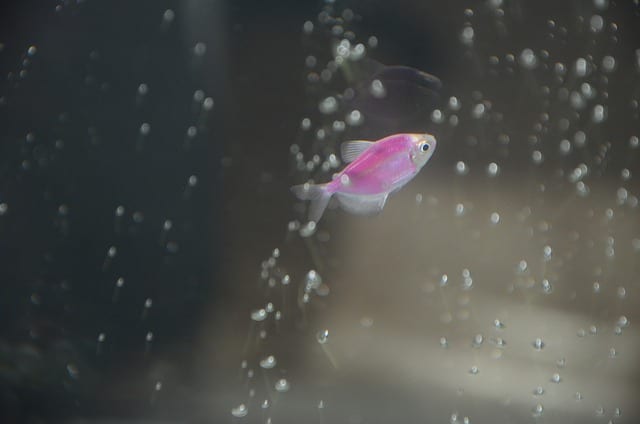Starting your own home aquarium is a great way to enjoy the beauty of aquatic life. Not only do they look amazing, but taking care of these wonderful creatures can be an incredibly rewarding experience.

If you’re a beginner, you must take the necessary precautions when creating your tank. Fish and other aquatic animals are fragile and require extensive care.
Below we are going to take a look at ten common mistakes that you should avoid so that you know the best techniques and procedures to start your underwater journey.
Interested in learning more? Then keep on reading!
Not Doing Enough Research
Building a home aquarium is certainly not an easy task. There are a lot of different factors involved in order for your fish to thrive, so it’s crucial that you do some research.
For instance, saltwater tanks and freshwater tanks require a completely different level of care. You’ll need to assess the pros and cons of each before diving in and purchasing your supplies.
Check out some popular blogs, such as Aquanswers to get started. You may also want to speak to others who have started their own aquarium for one-on-one advice. They can share valuable knowledge based on their past experiences.
Lack of Regular Maintenance
Maintaining your aquarium is a huge commitment. Without following the correct procedures, you will lose all of your fish and ruin the entire environment within your tank.
While they may be low maintenance compared to other pets, you still need to think of it as a full-time job. Each week and month, you’ll need to clean, test, and change your filter to ensure that it’s a healthy home. They also need to be fed regularly.
Overfeeding Your Fish
Speaking of food, it’s easy to fall into the temptation of feeding your fish more frequently than you should, but this can be incredibly harmful. Overfeeding can lead to water issues and health concerns as some species don’t need to eat that often.
To ensure that they are getting exactly what they need, stick to a schedule and only give them what is recommended. This should be outlined on the food package you purchase and is rarely more than once or twice a day (sometimes less).
Neglecting Water Quality
Water quality is vital for all aquatic animals. Neglecting to maintain it will cause significant problems and ultimately, you’ll lose your fish.
Be sure that you invest in a water testing kit, and track the PH, hardness, ammonia, and nitrate levels before adding any to the tank. After it’s well established, you’ll still need to test every month, as problems can brew over time.
The sooner you identify issues, the quicker you can make changes to protect the health of your aquarium. It’s a big part of tank maintenance.
Not Understanding Fish Compatibility
A common mistake that many beginners make is choosing incompatible fish. Just like other animals, certain types do not get along, and you’ll notice aggressive behavior very quickly.
Research each species you are interested in and double-check that they can coexist peacefully together. You’ll want to choose options that have a good temperament and share similar water requirements.
Failing to Cycle the Tank
Cycling the tank is something that a lot of beginner tank owners overlook. It’s a procedure that creates a biologically safe environment by introducing nitrifying bacteria to regulate the nitrogen cycle.
This helps break down waste and convert it into a safe form for the fish. A complete cycle usually lasts between 6 to 8 weeks.
You should let the aquarium settle for around 48 hours before adding anything to the tank. As mentioned above, testing is important here.
Adding Too Many Fish and Overcrowding
Tanks look great when they are full of colorful fish, but overcrowding the area can lead to several problems. Not only will you experience poor water quality, but your fish may start to show signs of aggression and contract diseases.
Always calculate the appropriate number of fish before you make any purchases. As a guide, it’s recommended to follow the one-inch of fish per gallon rule. However, factors such as any included tank additions (plants, decorations) and species/type can impact this.
Not Providing Proper Filtration
Much like water quality, proper filtration is another essential aspect of maintaining a healthy aquarium. It is responsible for removing excess food, fish waste, and debris from the water so that it remains clear.
If you don’t install a high-quality system, your water will quickly become cloudy and contaminated with hazardous materials. Again, you’ll need to research to find the most appropriate design for your tank size and fish type.
Ignoring the Needs of Your Fish
Different aquatic animals have different needs. From the food that they eat to the environment they live in – you must understand their individual requirements.
It’s your job to provide them with the necessary conditions for their well-being. Without doing this, you’re not going to see much success with your tank.
Consider keeping a journal and jotting down notes about the species you are interested in. It’s a simple step that can come in handy during those first few months of building your aquarium.
Taking on Too Much Responsibility
Finally, while you may wish to create a big, beautiful thriving tank, you have to be careful not to take on too much responsibility. As we previously discussed, fish require a lot of hard work.
As a beginner, you may not have the knowledge or time to care for an elaborate aquarium. Start small and once you’ve mastered that you can upgrade as your experience grows. You don’t want to go purchasing any expensive fish until you’re an expert!
Final Words
There’s no denying that starting your home aquarium is an exciting journey, but you must take care when beginning the process. By avoiding some of the most common mistakes and conducting research, you can give your new underwater friends the best start in life.
